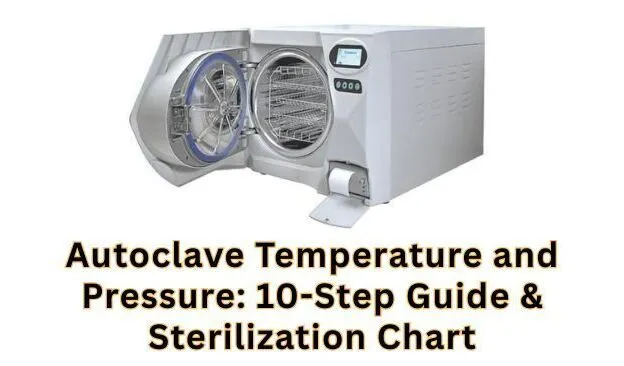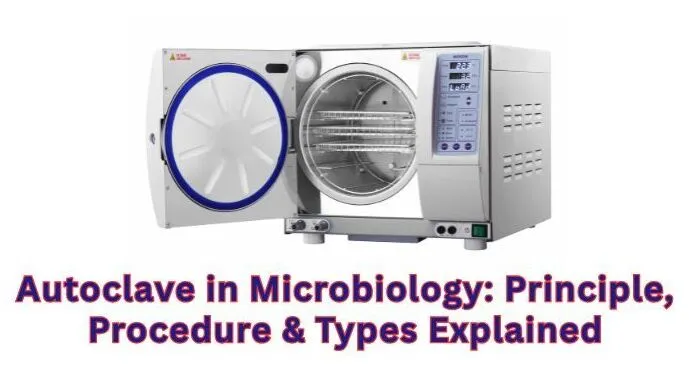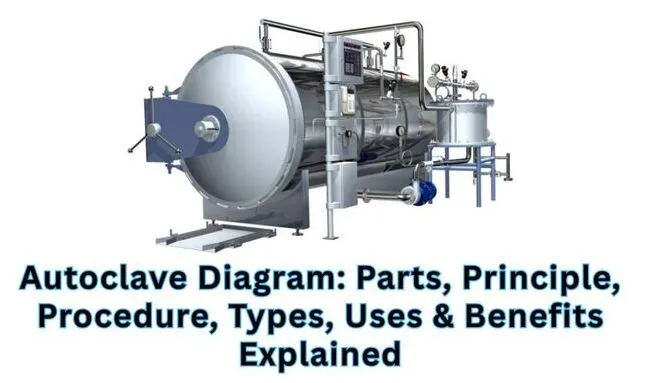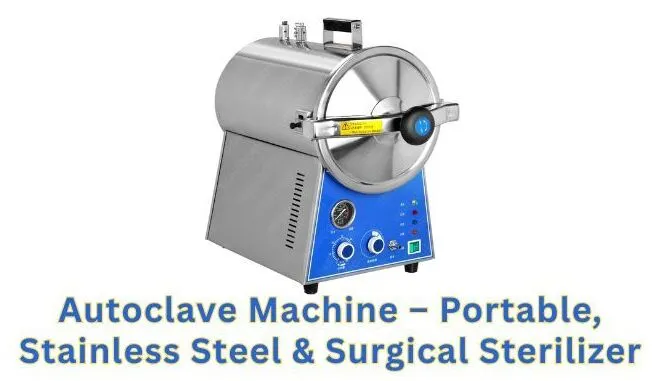Do you ever feel that you’re doing everything correctly however your autoclave isn’t working as it ought to? Maybe you’re working with non sterilized equipment, or perhaps your lab results continue to come in the wrong direction. It can be frustrating, particularly when you’re adhering to the regulations but don’t get clear, accurate results. Then you start to wonder, “Is it the autoclave temperature and pressure? Am I missing something small that changes everything?” You’re not the only one.
This blog will help you understand the basics. Learn the proper Autoclave temperature and pressure settings for various applications, why they are important, and how to avoid the most common errors. If you work in a laboratory, dental clinic and tattoo salon, these guidelines will ensure flawless sterilization everytime. Let’s go through it into steps, easy, simple and easy.
What is Autoclave Sterilization
Autoclave sterilization utilizes high pressure steam to kill organisms as well as viruses, fungi and spores that are found on equipment and equipment. This technique is used extensively in labs, hospitals and clinics across Pakistan. It aids in the prevention of infections and provides a clean conditions for surgical procedures and clear procedures.
The sterilization process is carried out by making steam from water creating pressure in the chamber, and finally achieving the correct temperatures and the right pressure. Equipment like hypodermic needles, wrapped items and porous substances remain clean after every sterilization cycle. Sterility Assessment Level (SAL) is a measure of the effectiveness of sterilization by analyzing the burden of microbes.
How Autoclave Sterilization Works
The autoclave chamber is filled with high temperature steam produced by an engine that generates steam. Inside steam conduction, the steam creates heat that can reach 121-134degC dependent on the weight. The bulk sterilizers employ this technique to ensure full steam penetration into the item.
System like the pre vacuum sterilizer or gravity displacement autoclave can help eliminate air prior to steam entering. This helps improve the outcome of sterilization. Instruments such as Personal Protective Equipment (PPE) undergo an entire cycle that includes validation of the cycle, cooling phase, as well as sterilizer maintenance in accordance with the standard operating procedure (SOP).
The Role of Pressure in Autoclave Sterilization
The Ideal Gas Law shows how the relationship between temperature and pressure affects sterilization. As the chamber pressure increases steam’s role as a heat transfer medium gets more efficient. The pressure causes steam to penetrate into layers of wrapped products crucial for the sterile processing.
The use of a pressure gauge can ensure that the correct temperature and pressure is maintained throughout the process. If there’s a chamber drain blockage or steam trap issue and negative pressure sterilization is not successful. Regularly checking autoclave problems and safety guidelines ensure that accidents are avoided and help keep the system operating properly.
You May Also Read This Blog: Cbc Machine: Hematology Analyzers, How It Works, and Financing
Optimizing Temperature for Steam Sterilization
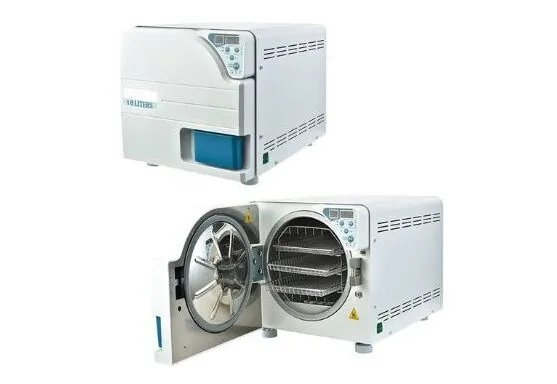
A proper temperature control is essential to kill microbes. The pressure and temperature of the autoclave must be at 121°C at 15 psi or 134degC when pressure is 30 psi. This will depend on the types of loads and items that are heat sensitive. The correct setting will result in more effective sterilization and lessens the possibility of corrosion in material.
In Pakistan tables top sterilizers at clinics as well as high throughput sterilization systems in hospitals must be in line with set parameters. Monitoring the time of sterilization and using bio indicator tests Bowie Dick tests and vacuum leak tests are all a part of cycle confirmation. Experts such as Bill Warren suggest tracking liquid cycle ramp downs and following a clearly defined maintenance schedule in order to prevent autoclave failure.
Requirements for Autoclaving
The sterilization of medical instruments in hospitals such as Central Sterile Services (CSS) requires careful monitoring of the autoclave temperature and pressure. Every sterilization process is dependent on the type of load that is being sterilized, including wrapped items and porous materials or items that are sensitive to heat. The items should be governed by an operating procedure standard (SOP) to stop contamination by microbial organisms and to keep the results of sterilization safe.
A bulk sterilizer should have a pressure gauge that is operational, a steam generator, as well as safety stop mechanisms. PPE is a personal protective device (PPE) is required for handling. The sterilization procedure should be in the correct temperature pressure ratio in order to reach requirements of the Sterility assurance level (SAL). Issues such as clogging of the drain in the chamber or steam trap failure or a poor cycle validation could hinder the effectiveness of sterilization.
Pressure and Steam
The steam used as a heat transfer medium performs best in high pressure steam conditions. The gravity displacement autoclave or sterilizer with pre vacuum needs to let air out in order to permit the steam to penetrate deep. Steam hits all parts of the equipment, including in hollow devices such as hypodermic needles, which assists in stopping the growth of microbes.
The majority of table top sterilizers as well as autoclaves with jackets operate between 15 and 30 psi to maintain correct pressure in the chamber. By using the Ideal Gas Law, more pressure can increase temperature. This will ensure that the equipment is free of bacteria. If they are not maintained, autoclave troubleshooting is required to correct leaks, negative pressure or other issues with steam autoclaves.
Temperature
The proper temperature control is essential for autoclave sterilization. A constant sterilization temperature of 121°C to 134°C will to kill bacteria rapidly through steam sterilization. The temperature must be maintained throughout the sterilization process to ensure that every product inside the autoclave chamber safe and secure.
The tests for biological indicator as well as the Bowie Dick test determine if the heat is reaching all areas in the system. The relationship between temperature and pressure must remain in balance throughout the entire run. If not, maintenance of the sterilizer is essential. In countries such as Pakistan regular checks can minimize the chance of corrosion related materials and ensure that devices such as sterilization of medical instruments available for use.
Time
The proper sterilization duration is just as important as pressure and heat. A complete cooling phase is required following the heating. In the case of ramp downs in liquid cycles long periods, they are needed to avoid the risk of spills or damages. The typical cycle validation time is between 15 and 60 minutes, based on the best practices for load configuration.
For sterilization that is high throughput, each autoclave must adhere to an exact schedule. If the duration is not long enough, bacteria might remain. Long periods of time consume energy. Autoclaves that have sustainability features assist in balancing energy usage. Regularly scheduled testing and logs prevent delays, identify issues in the early stages and guard against errors which could compromise sterilization efficiency.
Table: Common Autoclave Types and Settings
| Autoclave Type | Pressure (psi) | Temperature (°C) | Time (min) |
| Gravity Displacement | 15 | 121 | 30 |
| Pre vacuum Sterilizer | 27–30 | 132–134 | 4–5 |
| Table Top Sterilizer | 15–30 | 121–134 | 20–60 |
| Bulk Sterilizer | 30+ | 134+ | 60+ |
This article was written for Pakistan’s healthcare professionals as well as laboratory workers who rely on the safety of autoclave temperature and pressure monitoring. By following autoclave safety procedures, you reduce the risk of accidents and provides the safety of all.
Autoclave Temperature and Time Pressure Chart
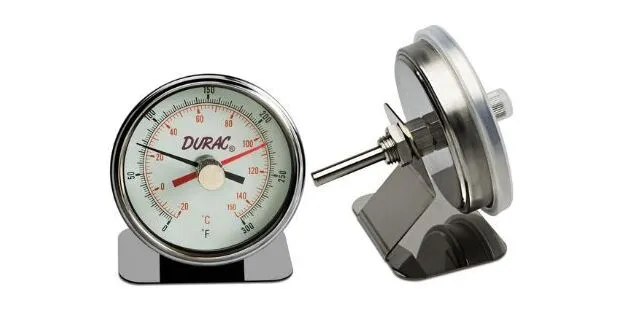
Knowing the correct autoclave temperature and pressure is essential for efficient steam sterilization in hospitals such as Central Sterile Services (CSS). The sterilization process is dependent on the precise control of temperature and pressure gauge readings in the chamber for sterilization. The high pressure steam destroys bacteria and guarantees an appropriate sterility level. This Ideal Gas Law explains how pressure influences temperature, which is both essential for sterilizing porous materials, wrapped products, as well as objects that are sensitive to heat.
The steam generator provides high temperature steam. Moreover, machines like gravity displacement autoclaves as well as sterilizers that pre vacuum adjust temperature and pressure according to the type of load. Utilizing biological indicators and Bowie Dick tests can help verify the result of sterilization. The operators adhere to strict safety guidelines in addition to wearing personal safety apparatus (PPE) to prevent dangers. Regular maintenance and monitoring can avoid problems like a chamber drain clog or malfunctioning steam traps making sterilization safe.
Temperature and Time Requirements in Autoclave Sterilization
The autoclave temperature and pressure have to be in the right range to ensure that the autoclave sterilization process is effective. Most commonly, 121degC at 15 psi for 15 – 30 minutes kills the majority of microbes that are killed during the sterilization process. Higher temperatures, like 134degC, will reduce the time for sterilization, but require careful monitoring with the gauge of pressure. A liquid based cycle needs a slower cooling to shield heat sensitive objects from damage and prevent autoclave failure.
For bulk sterilizers or those that are heavy the length of the cycle is longer to ensure steam to penetrate. The process of cycle validation makes sure that all components of the load meet sterilization conditions. A proper load configuration and a keen eye on the temperature pressure relationship increase the effectiveness of sterilization. The autoclave should be maintained regularly. sterilizer maintenance ensures that the machine is operating smoothly, providing an environment that is sterile and prevents contamination by microbial.
Time and Temperature in Autoclaving
The proper balance between temperatures and time will ensure that every sterilization cycle is successful in killing microbes. Steam sterilization relies on high pressure steam to quickly transfer heat within the chamber of an autoclave. Temperature and pressure increase together, which is explained in the Ideal Gas Law, which aids the staff in understanding the results of sterilization.
Healthcare employees in Pakistan using table top sterilizers as well as bulk sterilizers should be careful to follow the standard Operating Procedures (SOP) for temperatures and time. Biological indicators verify the process. The cooling stage is vital, as rapid cooling can result in damages or even a failure in sterilization. The monitoring of problems such as the failure of the vacuum leak test, or steam trap issues permits quick autoclave troubleshooting, making sterilization safe and efficient for sterilization of medical instruments and the control of infection.
| Temperature (°C) | Pressure (psi) | Sterilization Time (min) | Common Use |
| 121 | 15 | 15-30 | General sterilization |
| 132-134 | 27-30 | 3-5 | Pre vacuum sterilizers |
| 121 | 15 | 20-60 | Bulk sterilizers |
This manual is intended to assist professionals in Pakistan know how autoclave temperatures and pressure interact in the process of steam sterilization. The following guidelines ensure sterilization and shields people from the risk of infection.
10-Step Guide to Autoclave Temperature and Pressure
The correct autoclave temperature and pressure can destroy harmful microbes, and provide an assured level of sterility. In areas such as Central Sterile Services (CSS) actions such as checking the pressure gauge as well as setting the correct temperature controls and loading equipment like hypodermic syringes by using the proper load configuration guidelines must be followed.
Healthcare professionals must evaluate steam penetration by using bio indicator tests as well as the Bowie Dick testing. The sterilization process has to be carried out by using steam as a transfer medium. Equipment like a gravity displacement autoclave or table top sterilizer or a pre vacuum sterilizer require regular inspections to avoid chamber drain obstruction and steam trap malfunctions and low pressure in the chamber.
Read More: Our Products
Overcoming Autoclave Temperature & Pressure Challenges
The management of problems related to the autoclave temperature and pressure relation ensures that the sterilization process is safe. If pressure decreases or the pressure is negative and it results in failure of the sterilization process. Repairing the autoclave quickly and performing the test for leaks in the vacuum helps keep medical instruments safe from the bacterial burden.
In the course of troubleshooting an autoclave experts such as Bill Warren suggest checking the steam generator, sterilizer calibration as well as safety stops. Insufficient cooling times or a wrong sterilization process could impact the speed of sterilization. A proper maintenance plan ensures that the autoclave is safe and clean for everyday use particularly in hospitals across Pakistan.
10 Tips for Maximizing Autoclave Performance
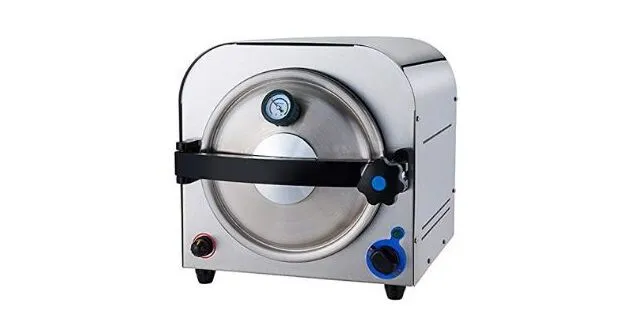
To enhance the sterilization process in autoclaves to improve sterilization, ensure the chamber is correctly loaded with wrapped items or porous materials. objects that are sensitive to heat. Don’t overload the chamber. Use the proper Standard Operating Procedure (SOP) to prevent errors. Always test cycles with a biological indicator, and ensure that the cycle validation process is done.
Select the correct sterilization cycle according to load type. Make sure you use high quality personal protection equipment (PPE) and ensure the safety guidelines for autoclaves each week. Equipment must be cool when the liquid cycle ramps down. Avoid using corrosion prone materials particularly when using autoclaves with jackets older than. This helps keep both the load as well as equipment in great working order.
Autoclave Safety Protocols
The strict autoclave safety procedures can reduce the risk. Make use of the pressure gauge prior to every run to verify the setting. Check that the temperature and pressure are in line with the type of load. Utilize the Ideal Gas Law to explain heat build up and to prevent damages to sterilization and medical equipment trays.
Personnel must wear all protection equipment (PPE) while making an opening to the autoclave. When operating, any sound leaks, apprehensions, or failures must be immediately reported. Make sure the outside of the unit is cleaned as part of routine sterilizer maintenance. This prevents infection or breakdown of the machine, as well as inadequate sterilization in medical facilities all over Pakistan.
Keep Your Autoclaves Running at Peak Performance with Capasee Electro Medical Engineering
Capasee Electro Medical Engineering keeps the autoclave temperature and pressure constant with its expert services in Pakistan. They examine for pressure, wash the sterilization chamber and check the steam generator for problems like a malfunctioning steam trap or clogging of the drain in the chamber and ensure safe steam sterilization in laboratories and hospitals.
The autoclave’s trained staff adheres to safety guidelines and follows the the standard operating procedure (SOP) for every machine. This ensures that autoclaves are not damaged during the sterilization process and ensures that heat sensitive items such as porous materials and wrapped items from poor results. Capasee additionally improves temperature control and cycle verification for every type of load.
Biological Indicators (BIs) in Autoclave Validation
The tests for biological indicators are the most reliable method to ensure the sterilization of an autoclave has been successful. The indicators are made up of endospores that are extremely difficult to eliminate. If steam at high pressure destroys the spores then the level of sterility assured is attained. This method helps in ensuring sterilization effectiveness for Central Sterile Services (CSS) units throughout Pakistan.
These tests aid in evaluating the entire sterilization process, particularly for bulk sterilizers and pre vacuum sterilizers, as well as the use of table top sterilizers. Indicators can be used to transfer heat and are based on the best practices for load configuration. They can also identify failures due to temperature pressure relationship issues or incorrect vacuum leak test methods.
The Use of Endospores
The Endospores microbe is a hardy one utilized in biological indicators that test the sterilization process’s results. They can withstand heat and must be completely destroyed by high temperature steam during the process. This will ensure that no microbial contamination remains on surgical instruments and hypodermic syringes as well as other sterilization of medical instruments.
Endospore testing is a common practice in the validation of autoclaves by laboratory technicians and is a part of the modern autoclave safety protocols. This procedure helps in achieving the proper Sterility Assurance Level (SAL) and helps ensure conformity with sterilization standards for healthcare. Endospore testing can also help sustain sustainability by avoiding failures in reprocessing and also reducing the energy consumption during repeat sterilization.
Effectivity Validation
Validation of the effectivity proves that the autoclave temperature and pressure were enough to eliminate harmful microbes. This is done by performing a Bowie Dick testing, conducting cycle validation and then confirming the destruction of spores by tests for biological indicators. These steps assist labs as well as clinics across Pakistan make sure that they can reuse their tools safely. of equipment.
Validation also includes determining the time for sterilization, observing the cooling phase, and ensuring the safe pressure in the chamber. Any pressure drop or negative pressure has to be rectified immediately. This prevents delays in the process of high throughput sterilization. It also aids in preventing infections caused by the high level of microbial contamination in sterile processing facilities.
Autoclave Use
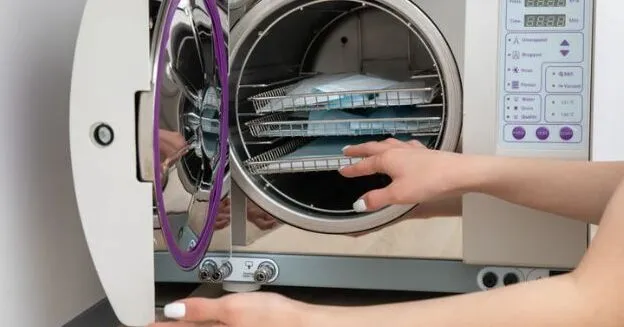
Autoclave temperature and pressure steam and controlled pressure and temperature to destroy bacteria. This process is crucial for sterilization of medical instruments and infection control as well as maintaining sterile conditions in labs, hospitals, and clinics. Steam sterilization removes all microbial contaminants from wrapped items and tools that are open.
In order to ensure a correct result of sterilization, every sterilization cycle should be matched to the type of load. Things like porous materials as well as heat sensitive objects and liquids require a different cycle of sterilization lengths and temperature controls. The wrong setting could result in autoclave failure or failure to validate the cycle and low steam penetration.
Autoclave Cycles
Each autoclave chamber operates using different autoclave cycles according to the kind of material. The Pakistani Central Sterile Services (CSS) personnel must adhere to the standard operating procedures (SOPs) to ensure proper use of the cycle. This will ensure proper calibration of the sterilizer and helps prevent obstructions to draining the chamber and maintains the ideal pressure temperature relationship during sterilization.
Gravity displacement autoclaves, vacuum sterilizers, and bulk sterilizers all make use of different cycles to suit requirements. Table top sterilizers are suitable for clinics, whereas jacketed autoclaves are typically utilized in large labs. A good cycle validation, and the use of an approved pressure gauge will safeguard against bad results and allow for high throughput sterilization.
Liquids Cycle
The liquid cycle utilizes smaller chamber pressures and a longer sterilization times to ensure the stability of liquids. It regulates the cooling process carefully to prevent rapid boiling. This setting is ideal for use in laboratory autoclaves in which broths, flasks and medical fluids can be cooled using steam as a heat transfer medium.
The cycle incorporates an increase in the rate of liquid cycling to lower autoclave temperature and pressure and pressure gradually. This helps protect corrosion prone material from being damaged and ensures the safety of the container. Incorrectly performing this process could result in spills or damaged containers. It is essential to maintain the sterilizer properly to prevent steam trap malfunction.
Solids or Dry Cycle
Dry cycle, also known as the solids is utilized for open objects such as hypodermic syringes and surgical instruments or tray. These items require direct high temperature steam as well as strong steam penetration. It is crucial to check the pressure gauge and the steam generator for accuracy throughout this process to prevent autoclave problems later on.
This cycle is based on this cycle according to the Ideal Gas Law, where pressure and temperature must increase together. Overheating or negative pressure can harm tools. If you follow the correct autoclave safety guidelines and a regular maintenance program, CSS staff can prevent low sterilization efficiency and ensure the complete removal of microbial burdens from the instruments.
Wrapped Goods or Pre Vacuum Cycle
The wrapped items or pre vacuum cycles remove air prior to introduction of steam. This aids in the penetration of steam into porous materials such as gauze, surgical kits and bandages. A sterilizer that is pre vacuum employs a leak test and a Bowie Dick test to make sure that steam is able to penetrate deeply and evenly throughout the type of load.
This cycle is suitable for instruments that are complete or wrapped items that are used in surgery. It provides the highest quality Sterility Assurance Level and adheres to strict sterilization guidelines for healthcare. With a proper load configuration, good practices and appropriate use of personal protective equipment (PPE) This cycle is safe and high quality autoclave sterilization throughout the Pakistani healthcare system.
Steam Sterilization
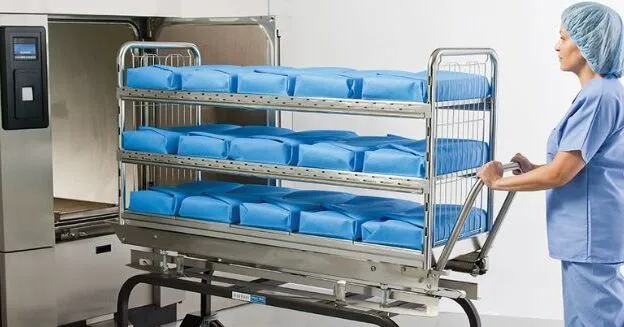
Steam sterilization is the best dependable method employed in labs and hospitals across Pakistan. Steam sterilization uses high pressure to kill viruses, bacteria and spores. A suitable autoclave temperature and pressure are required to complete the sterilization process properly. This method provides a very the highest level of sterility. Assurance Level.
When using gravity displacement autoclaves sterilizers that are pre vacuum, as well as large sterilizers, the steam is pumped into the autoclave’s chamber and eliminates air to allow for greater steam penetration. It is the Ideal Gas Law explains the connection between pressure and temperature. A proper temperature control will ensure that heat sensitive products wrapped products, wrapped items and other porous materials are thoroughly sterilized.
FAQ’s
What is autoclave pressure and temperature?
The pressure of the autoclave is about 15 psi. Temperature is usually 121 degrees Celsius, which is which kills all germs using high pressure steam.
Why is autoclaving done for 15 minutes?
15 minutes guarantees complete elimination of microbial contamination and is in line with the requirements for Sterility level (SAL).
How long to autoclave 250 ml?
A 250ml load of liquid typically requires 20 to 25 minutes at 121degC for a safe steam sterilization.
Why is autoclave done at 121 C?
At 121°C, autoclave temperatures and pressure kill bacteria as well as spores with ease, and without harming most objects.
Why is it called autoclave?
Autoclave is the name given to it because it locks automatically the sterilization chamber. It also uses steam as a medium for heat transfer.
Conclusion
Autoclave temperature and pressure are essential to the process of achieving safe and complete steam sterilization. By ensuring the proper amounts of steam at high pressure and heat autoclaves guarantee that microbes are eliminated from medical instruments such as liquids, equipment and tools. Understanding the relationship between temperature and pressure can to improve the efficiency of sterilization and assures an extremely high level of Sterility Assurance. When using a gravity displacement autoclave, or the pre vacuum sterilizer control of these elements will ensure an accurate cycle validation and a safe result for all sterilization requirements in Pakistan and around the world.

